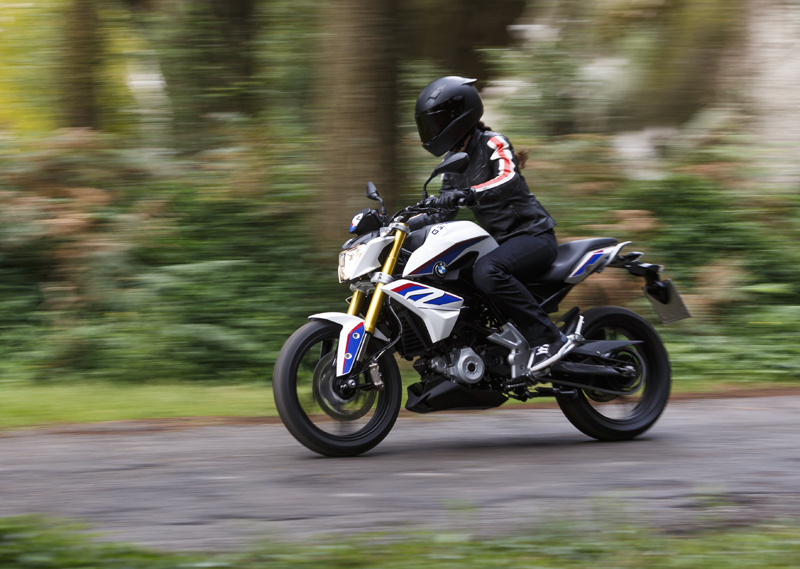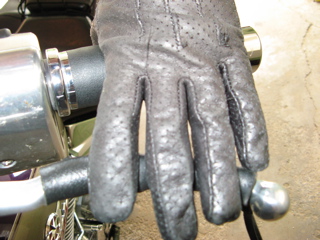Editors Note: Women Riders Now recommends those who want to learn how to ride a motorcycle enroll in a Motorcycle Safety Foundation training class. The following is a guide to help practice what was taught in the class. Women Riders Now highly discourages practicing these techniques without having first passed the MSF Basic RiderCourse or theHarley-Davidson Riding Academy New Rider Course.

a bicycle, you can
probably ride a motorcycle.
Hands on the grips, legs around the frame, catching wind with big grins on their freedom-road faces, motorcyclists make riding look easy. As you watch them glide on by, you muse, “I can do that.” And you can, once youve mastered some basic skills.
Operating a motorcycle blends the smooth operation of a manual transmission with the balance of riding a bicycle. Both are required to make the bike move. When you were 5, 6 or 7, you made the wheels spin by pedaling. Faster and faster you turned until you gained sufficient speed to stabilize the bike.
Sometimes a mother or dad, big brother or best friend placed a helping hand on the seat or rear fender and ran alongside for balance and moral support. Perhaps a not-so-gentle push propelled you up to speed, down the street, and off those training wheels. Later, if you learned how to work the clutch pedal in a car with a stick shift, you jerked the car forward into gear, and often stalled, while someone sat next to you in the passenger seat.
Not so with a motorcycle. No one is going to sit next to you or run alongside, push or hold you up when you wobble or jerk. There are no training wheels. And pedals dont make the bike go. To set the wheels spinning, you still need a bike, a sense of balance and a bit of speed. But to even begin to make a motorcycle move smoothly, you must get in the zone—the friction zone—and practice the fine art of clutch control.

The friction zone is the small wonder in the big world of motorcycling. The Motorcycle Safety Foundation (MSF) defines the friction zone as “the area of clutch lever movement that begins where the clutch starts to transmit power to the rear wheel and ends just prior to full clutch engagement.”
In short, the friction zone is where the clutch slips and the transmission grips, and partial power is transmitted to the rear wheel. Youll use the friction zone every time you ride. Stop signs? Lights? Slow moving traffic? Changing gears? If you want to avoid a jerky ride, youll have to find the friction zone.
So, where is the magic friction zone? Its all in the clutch, the lever mounted on the left hand grip. But no one can show you its exact location. The friction zone is something you cant see. You have to feel it.

Try this: With the bike turned off, locate the controls and learn the gearshift pattern. Straddle the bike, kick up the side stand, and find neutral (halfway between first and second gear). Practice operating the controls without looking at them. When youre ready, prepare to start the engine. Use FINE-C, a useful acronym to remind you of the following (something students learn in the Motorcycle Safety Foundation Basic RiderCourse):
Fuel valve on for carbureted motorcycles
Ignition on
Neutral gear
Engine cut-off switch on.
Clutch squeezed (Choke open, for a cold engine on a carbureted bike)
Finally, push the electric start button. With the engine running, ease out the clutch. Slowly. Since you started in neutral, you can ease the clutch all the way out and the bike will not move or stall. Now squeeze the clutch fully and shift to first gear by depressing the shift lever down with your left foot.
Time to find the friction zone. Ease out the clutch slowly while easing on the throttle very slowly. Take your time. Count to three. When the wheels begin to move, youve found the friction zone, and partial power is being transmitted to the rear wheel.
 |
 |
 |
When you are ready to roll, ease the clutch through the friction zone until fully released to completely engage first gear. Now the bike is rolling under power with minimal throttle. Hands on the grips, legs around the frame, you’re catching some wind with a great big grin. You don’t need anyone to sit or run alongside, push or hold you up. You can do it on your own. You and the friction zone.
About the Author
Susan Rzepka is a MSF RiderCoach who loves to ride, write, and help others who want to do the same. You enjoys riding her Yamaha V Star 1100 Custom.
Related Articles
Women Riders Now Beginners Guide
Safe Riding Tips stories on WRN


I just purchased my bike in May. This article is very helpful. I’m so glad I signed up to receive emails.
We’re glad you did too. Thank you for subscribing and for reading Women Riders Now. And congratulations on the purchase of your new motorcycle.
I am a new rider. I found these articles are very helpful. I’m starting on the HD Sportster SuperLow. That’s the bike for me. Love it but taking my time to get used to all that power.
This was a helpful article. I’m learning how to ride now. I have always ridden on the back with my husband and watched him. I will also keep this article in mind when I practice. My husband bought me a motorcycle for Valentine’s Day because I have always wanted to learn to ride myself. Will be looking for more helpful articles.
Be sure to carouse our in-depth Beginner’s Guide to Motorcycling. You’ll find a wealth of information there, including more safety and technique articles like this one.
Thank you. Super helpful.
Great article and very helpful! For women having difficulty maneuvering larger bikes, they should consider having the bike fitted for them at Roar Motorcycles for women in Daytona Beach, FL. It has worked wonders for me!
I have found these articles to be very helpful on riding my Honda VLX 600. I don't know if I will ever be so fortunate to own a larger bike because my husband does not ride. During the winter here in Ohio, I spend alot of time reading articles such as this one. I am going out west on my bike this year, 2009. It will be my first long trip of more than 200 miles. Am sure looking forward to this summer.
Enjoy your trip and safe travels.
I passed the MSF course last year, have a few miles under my belt. Took it to Arkansas last year. I feel, however, I am not making much progress, even though my husband says he sees marked improvement everytime we ride. I have a Kawasaki Vulcan 800, a gift from my beloved. I find the long front wheel cumbersome to make turns from a stop. Operating the clutch, throttle, brakes and balance seems overwhelming. I have never driven a stick, and am new to motorcycling. Everyone says I am “overthinking.”
I am finding this Web site is answering a lot of my questions, but any more advice specific to “parking lot” maneuvers would be greatly appreciated!
I have been riding for a year now. I barely put 1,000 miles on my 07 Sportster Nightster. I thought I was doing better with the friction control and turning, but I rode this past weekend and dumped my bike twice in the same day (ouch). I seem to have the hardest time turning to the right side. What do you think I am doing and what can I practice to get better at these right turns? I don't like dumping my bike. Please help. Thanks.
Diane,
Part of your problem may be that you are not leaning into the turn when you turn the bike. A turn on a motorcycle is more of a lean, than an actual turn of the handlebars. I remember I dumped a big touring bike early on in my riding years because it I turned the bars but my body didn't move with the bike. It's not like turning a car or an ATV.
Also, train your brain to look through the turn. Don't look right down at the turn as you will go where you look. Look through the turn and the bike will follow. Hope that helps. Keep us posted on your progress.
New rider (had scooters before). Seem to okay with flat ground, but the inclines and hills are killing me. I have dropped th bike a few times because of weight displacement on hills, I think. Also finding the zone when stopping on the hill is tough for me. Any suggestions?
We have an entire article about stopping on hills in our Riding Right section. Click on that link and scroll down (or visit the archives) to find the article. It should be very helpful to you.
Having just passed my MSF basic riding course yesterday on their Suzuki 125, I am extremely gratified to see this. I plan on doing this practice first on the Softail Deluxe my husband bought me for our 28th wedding anniversary las year. Thanks for the reminder.